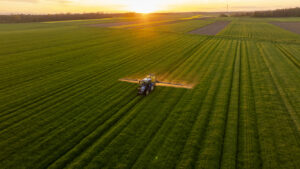Written by Gilly Kinsky, VP Marketing, CropX
In precision agriculture, irrigation management has always been a balancing act between what the soil holds and what the crop needs.
For years, soil moisture sensors have been the foundation of understanding water availability below the surface. The CropX evapotranspiration (ET) sensor has added a new dimension, revealing how much water the crop and atmosphere are actually consuming. Each offers critical insight on its own. But only together do they tell the whole story.
Two Different Views of the Same System
A field can be understood from two vantage points:
- The soil’s perspective: How much water is stored and available for roots.
- The atmosphere’s perspective: How much water is being lost through evaporation and plant transpiration.
Soil sensors measure what remains in the reservoir. ET sensors measure how quickly that reservoir is being drained. Together, they capture the full cycle of water movement, from the moment it enters the soil to the moment it leaves the canopy.
This dual view mirrors the plant’s own balancing act between taking in carbon dioxide and conserving water. Managing irrigation without both perspectives is like navigating with half a map.
The Role of ET: Measuring Water Demand in Real Time
Evapotranspiration combines two simultaneous processes: evaporation from the soil and transpiration from plants. It represents the real-time water demand of the field, a direct indicator of how much water is leaving the system each day.
ET sensors and models translate various variables into daily estimates of crop water use. A rising ET value often signals active growth and healthy transpiration. A sharp drop, on the other hand, may suggest that the crop is regulating itself due to stress or limited water availability.
But ET alone can’t tell whether the soil has enough water to support that demand, and that’s where soil sensors complete the picture.
The Role of Soil Sensors: Quantifying Water Supply
Soil moisture sensors are the cornerstone of precision irrigation. They reveal how much water is available in the root zone, the part of the field that truly matters for plant health. By continuously monitoring soil moisture levels, they provide an accurate, real-time view of how effectively water is stored and accessed by roots.
They answer critical management questions:
- Is there enough moisture to support the crop’s current growth stage?
- How quickly is water being drawn down from the soil?
- Is irrigation reaching the target depth and avoiding waste?
This information empowers growers to fine-tune irrigation schedules, avoid both under- and over-watering, and protect soil structure and nutrient availability.
But even the best soil data describes only one side of the equation: the supply. To understand the full picture of crop water dynamics, it helps to combine that insight with ET data, which reflects real-time water demand. Together, they form a powerful system where soil sensors anchoring what’s available below, and ET sensors capturing how that water is being used above.
Closing the Water Balance Loop
When soil and ET sensors work together, irrigation decisions become context-aware, guided by both supply and demand.
Soil sensors show what’s available beneath the surface; ET sensors reveal how much is being used above it. Together, they close the loop on the crop–soil–atmosphere water balance.
|
Component |
What It Measures |
What It Enables |
|
Soil Sensor |
Water supply in the root zone |
Identifies moisture depletion, infiltration patterns, and retention efficiency |
|
ET Sensor |
Water demand from the crop and atmosphere |
Tracks water use, stress, and overall irrigation efficiency |
|
Integration |
The full water balance (supply vs. demand) |
Enables predictive, adaptive irrigation decisions |
By linking both datasets, growers gain a richer understanding of what’s happening in the field, not just how much water is present, but how actively it’s being used.
For example:
- Low soil moisture combined with high ET signals strong crop demand and an approaching water deficit, irrigation should be planned soon.
- High soil moisture with low ET may indicate over-irrigation or a temporary slowdown in crop activity, such as during cooler or dormant periods.
- Steady ET alongside rapid soil depletion can point to infiltration inefficiencies or shallow rooting, suggesting a need to review irrigation depth and frequency.
When analyzed together, soil and ET data transform irrigation from a reactive routine into a predictive, adaptive system, one that responds dynamically to both crop behavior and environmental conditions.
From Reactive to Predictive Irrigation
Traditional irrigation relies on visible symptoms – dry soil, wilting leaves, declining yield.
Integrated sensing replaces reaction with anticipation. When ET data shows increasing demand and soil sensors confirm falling reserves, irrigation can be scheduled before stress occurs.
This proactive approach:
- Conserves water and energy.
- Protects root-zone stability and nutrient availability.
- Improves consistency in yield and quality.
The result is a more resilient growing system, tuned to the dynamics of the crop itself.
Toward a More Intelligent Water Strategy
Sustainable agriculture depends on aligning human decisions with natural processes.
By integrating ET and soil sensors, we create a closed feedback loop between soil, plant, and atmosphere, a continuous dialogue that allows for precise, timely, and informed irrigation.
To download our comprehensive ET white paper, click here.




